Viewing the Sun Safely
NEVER LOOK DIRECTLY AT THE SUN – VIEW WITH AN EXPERIENCED SOLAR OBSERVER – NO LIABILITY WHATSOEVER IF YOU DAMAGE YOUR EYES FOLLOWING THESE TIPS.
- If you have never viewed the sun with a telescope or other optical aid, get advice and view with someone who is an experienced solar observer.
- Cover up the finder – better still remove it – tape the cover in place so it cannot be removed
- To aim your telescope use the ‘scopes shadow, the sun will be lined up when the shadow cast by the tube is at it’s smallest. Alternatively you can mount a small tube parallel to the ‘scope and use its shadow to line up the telescope.
- Never leave your telescope unattended – not even for a few second.
- Think about what you are doing check and double check before looking through the eyepiece.
- Move the telescope out of the path of the Sun before removing the filters at the end of the observing session.
- There are only 4 safe ways to observe the sun, don’t use any others
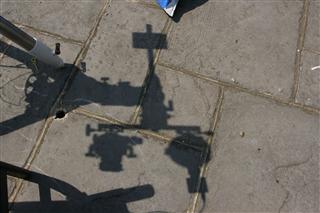
To aim your telescope use the ‘scopes shadow, the sun will be lined up when the shadow cast by the tube is at it’s smallest.
Projection
NEVER LOOK DIRECTLY AT THE SUN – VIEW WITH AN EXPERIENCED SOLAR OBSERVER – NO LIABILITY WHATSOEVER IF YOU DAMAGE YOUR EYES FOLLOWING THESE TIPS
I use a home-made projection box that goes over a 25mm eyepiece, this gives high contrast. There are some risks with this method, the telescope is concentrating the suns energy in the eyepiece, so use a simple eyepiece such as a ‘Kelner’ this type of eyepiece doesn’t have any cement so the only way to damage it is to get it so hot that it cracks – this has never happened to me – but could happen – I have safely viewed the Sun using a 300mm F4 reflector using this method but you should exercise caution as you are concentrating heat onto the secondary, a refractor telescope is better in this respect, don’t use a catadioptric telescope.
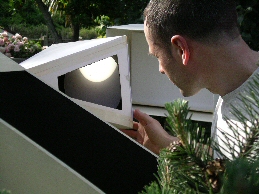
Alternative projection box, this box is connected to the counterweight arm of a German equatorial mount.
Note the black dot on the Sun is Venus during the 2004 transit of Venus from Crayford, England.

Solar Filter
NEVER LOOK DIRECTLY AT THE SUN – VIEW WITH AN EXPERIENCED SOLAR OBSERVER – NO LIABILITY WHATSOEVER IF YOU DAMAGE YOUR EYES FOLLOWING THESE TIPS
These should ALWAYS be full aperture (i.e. cover the front of the telescope) and be specified by the manufacturer for use as a solar filter on a telescope, be secure enough that it will not blow off and not be damaged.
Filter on right is a Baader solar film filter in a home made filter holder.
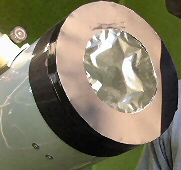
Home made filter holders
Clockwise from top left
- 70mm filter for a 200mm (focal length) Camera lens (fits beneath UV filter on front of lens)
- Binocular filters (note the Velcro on inside to provide a friction fit)
- Solar card
- Eclipse glasses

Solar image taken with 70mm filter (1) on a 200mm focal length lens, handheld, the filter is sandwiched between the lens and the skylight filter, making this a simple filter to make and easy to store, you also know it cant fall off!
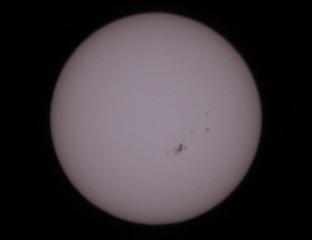
Dedicated Solar Telescope
NEVER LOOK DIRECTLY AT THE SUN – VIEW WITH AN EXPERIENCED SOLAR OBSERVER – NO LIABILITY WHATSOEVER IF YOU DAMAGE YOUR EYES FOLLOWING THESE TIPS
Manufactured for the purpose, these usually have a Hydrogen alpha filter fitted to the full aperture, or a full aperture energy rejection filter and an etalon (Hydrogen Alpha filter) further down the light train.
Don’t attempt to use a deep sky Hydrogen Alpha filter – it isn’t safe and will not show any prominences.
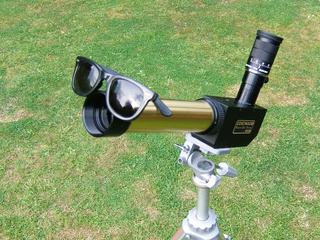
Herschel Wedge
NEVER LOOK DIRECTLY AT THE SUN – VIEW WITH AN EXPERIENCED SOLAR OBSERVER – NO LIABILITY WHATSOEVER IF YOU DAMAGE YOUR EYES FOLLOWING THESE TIPS
These fit to the focuser and filter most of the light and heat out to an ‘exhaust’ baffle leaving a bright disc that can be filtered with standard filters, some come with polarising filters these allow a variable brightness control by rotating the filters but some say that polarising filters can reduce contrast, so if you go to the expense of a Herschel wedge it may be worth investing in neutral density filters too (never use the neutral density or polarising filters without the Herschel wedge and always follow the manufacturers instructions. Only suitable for refractors.
Note early designs of Herschel wedges passed the unwanted light out the side where inquisitive eyes might look but the models I have seen in the last few years have baffles or screens to prevent this.
The Baader Herschel wedge comes with a solar continuum filter which brings out the contrast and a ceramic plate (same material as used on the space shuttle) to prevent any light going astray.
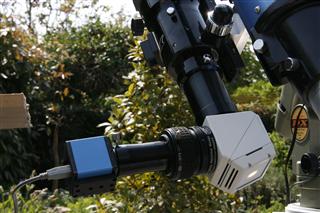
Baader Herchel wedge, this will give stunning white light views of the Sun, I rarely fail to see granulation and Faculae, this version has an out of focus sun on a screen to help aiming the telescope.
